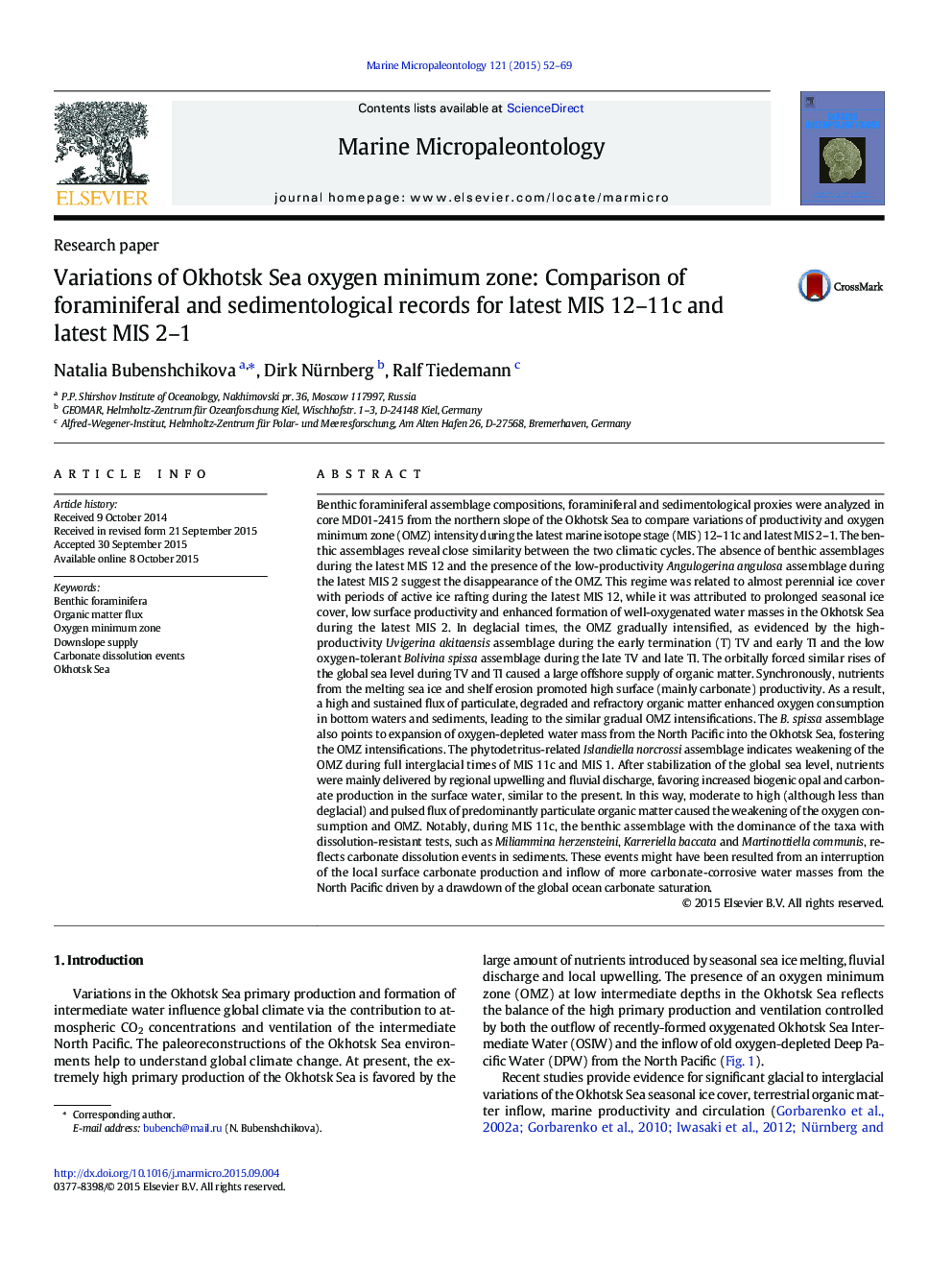| Article ID | Journal | Published Year | Pages | File Type |
|---|---|---|---|---|
| 4748760 | Marine Micropaleontology | 2015 | 18 Pages |
•Okhotsk Sea benthic foraminifera reveal analogy between two climatic cycles.•OMZ disappeared during glacial latest MIS 12 and latest MIS 2.•OMZ gradually intensified during TV and TI forced by close rises of sea level.•OMZ weakened during full interglacial times of MIS 11c and MIS 1.•Carbonate dissolution events appeared during MIS 11c only.
Benthic foraminiferal assemblage compositions, foraminiferal and sedimentological proxies were analyzed in core MD01-2415 from the northern slope of the Okhotsk Sea to compare variations of productivity and oxygen minimum zone (OMZ) intensity during the latest marine isotope stage (MIS) 12–11c and latest MIS 2–1. The benthic assemblages reveal close similarity between the two climatic cycles. The absence of benthic assemblages during the latest MIS 12 and the presence of the low-productivity Angulogerina angulosa assemblage during the latest MIS 2 suggest the disappearance of the OMZ. This regime was related to almost perennial ice cover with periods of active ice rafting during the latest MIS 12, while it was attributed to prolonged seasonal ice cover, low surface productivity and enhanced formation of well-oxygenated water masses in the Okhotsk Sea during the latest MIS 2. In deglacial times, the OMZ gradually intensified, as evidenced by the high-productivity Uvigerina akitaensis assemblage during the early termination (T) TV and early TI and the low oxygen-tolerant Bolivina spissa assemblage during the late TV and late TI. The orbitally forced similar rises of the global sea level during TV and TI caused a large offshore supply of organic matter. Synchronously, nutrients from the melting sea ice and shelf erosion promoted high surface (mainly carbonate) productivity. As a result, a high and sustained flux of particulate, degraded and refractory organic matter enhanced oxygen consumption in bottom waters and sediments, leading to the similar gradual OMZ intensifications. The B. spissa assemblage also points to expansion of oxygen-depleted water mass from the North Pacific into the Okhotsk Sea, fostering the OMZ intensifications. The phytodetritus-related Islandiella norcrossi assemblage indicates weakening of the OMZ during full interglacial times of MIS 11c and MIS 1. After stabilization of the global sea level, nutrients were mainly delivered by regional upwelling and fluvial discharge, favoring increased biogenic opal and carbonate production in the surface water, similar to the present. In this way, moderate to high (although less than deglacial) and pulsed flux of predominantly particulate organic matter caused the weakening of the oxygen consumption and OMZ. Notably, during MIS 11c, the benthic assemblage with the dominance of the taxa with dissolution-resistant tests, such as Miliammina herzensteini, Karreriella baccata and Martinottiella communis, reflects carbonate dissolution events in sediments. These events might have been resulted from an interruption of the local surface carbonate production and inflow of more carbonate-corrosive water masses from the North Pacific driven by a drawdown of the global ocean carbonate saturation.
Graphical abstractFigure optionsDownload full-size imageDownload high-quality image (389 K)Download as PowerPoint slide
